Dungeon Crawlers/RPGs are a popular genre for board and video games. They generally appeal to a more niche audience though for a number of reasons. Many of them have more complicated rules and a learning curve which turns off a lot of players. Originally released back in 2016 One Deck Dungeon is unique in that it streamlines the whole genre into a set of cards and dice. Instead of a complicated rule set you basically roll dice trying to match specific dice combinations in order to succeed in various encounters. Due to its success One Deck Dungeon has received a number of expansion packs.
Year: 2016 | Publisher: Asmadi Games | Designer: Chris Cieslik | Artist: Alanna Cervenak, Will Pitzer
Genres: Card, Cooperative, Dice, Dungeon Crawler, Family
Ages: 14+ | Number of Players: 1-2 | Length of Game: 30-45 minutes
Difficulty: Light-Moderate | Strategy: Light-Moderate | Luck: Moderate
Components: 5 hero cards, 30 dice, 44 encounter cards, 4 level cards, 5 dungeon/boss cards) 2 basic skill cards, stairs card, turn reference card, 15 damage tokens, 6 potion tokens, campaign sheet pad, instructions
Where to Purchase: Amazon, eBay
Any purchases made through these links (including other products) help keep Geeky Hobbies running. Thank you for your support.
Objective of One Deck Dungeon
The objective of One Deck Dungeon is to successfully make your way through the dungeon without running out of health. When you reach the boss you must defeat it in order to win One Deck Dungeon.
Setup for One Deck Dungeon
- Each player chooses a hero card. If you are playing solo you will turn the card to the 1P side and for a two player game you will use the 2P side.
- Choose a dungeon card and turn it to the side corresponding to the number of players. Slide this card underneath the Turn Reference card so only the first floor of the dungeon is showing.
- Stack the level cards by number with the level one card on the top.
- Shuffle all of the encounter cards and place the deck face down. Place the stairs card on the bottom of the deck.
- Return the unused heroes and dungeons to the box.
- Place all of the dice and tokens in the middle of the table to form the supply.
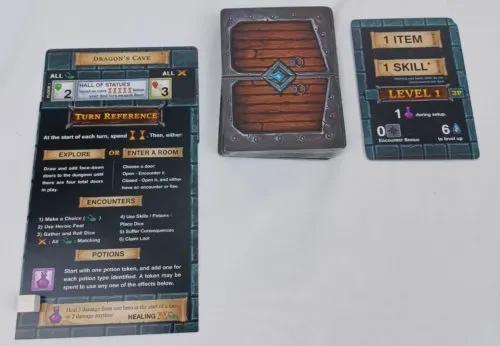
The Dice of One Deck Dungeon
The dice used in the game are different colors. Each color die corresponds to a different type of skill.
- Yellow – strength
- Pink – agility
- Blue – magic
- Black – heroic
Each dice will be used for the corresponding colored tasks.
Dice in One Deck Dungeon will generally be placed in three different areas.
- General Supply – These dice do not belong to any of the players, and is just a place where dice that aren’t currently being used reside. Whenever you use a dice or a token it will be returned to the general supply immediately. All dice are returned to the general supply after an encounter is finished (unless otherwise stated). If the general supply ever runs out of a type of dice, you cannot use any more dice of that color during the current encounter.
- Dice Pool – The dice pool consists of all of the dice that belong to each player. Each player’s dice pool is separate. Dice in each player’s dice pool can be used to complete challenges on encounter cards.
- Encounter Cards – The main objective of One Deck Dungeon is to complete encounters in order to gain experience, skills, items, etc which will help you as you advance in the dungeon. Players will play dice from their dice pool in order to cover up spots on encounter cards.
Playing Dice
You can play dice for encounters in a number of different ways.
Boxes that are about the size of one dice can only be filled with one die that matches the color and are equal to or higher than the number printed on the space.
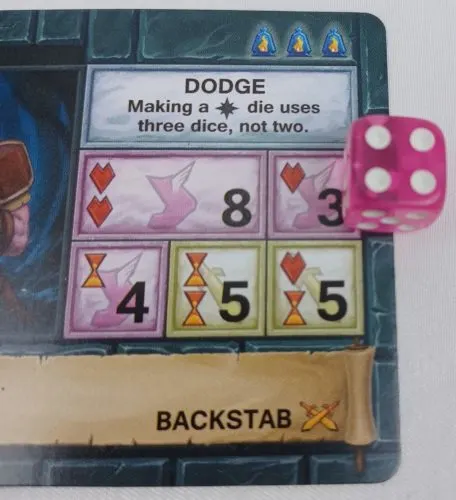
Boxes that are larger than a single dice can be filed with multiple dice of the color featured on the box. To complete the challenge you must place dice on the box that add up to at least the number printed on the box. In two player games both players can place dice on these boxes.
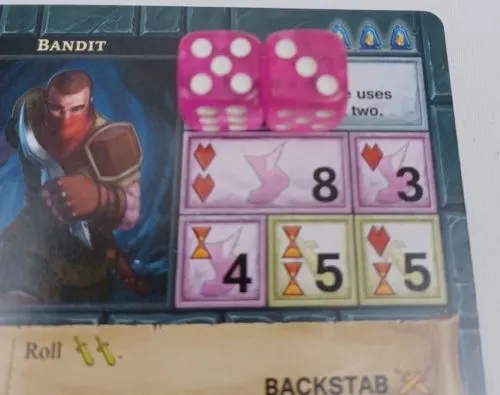
At any time a player can exchange two of their dice of any color for a black die. The value of the black die will be equal to the lower number of the two dice given up. If you are playing with two players, both players can trade in one die to get a black die. The players will then choose who gets to take the black die.
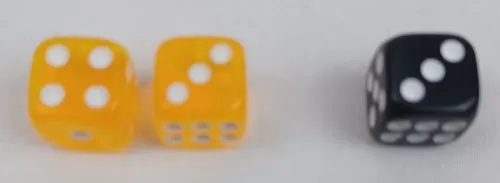
Heroic/black dice are treated as wilds and can act as any other color.
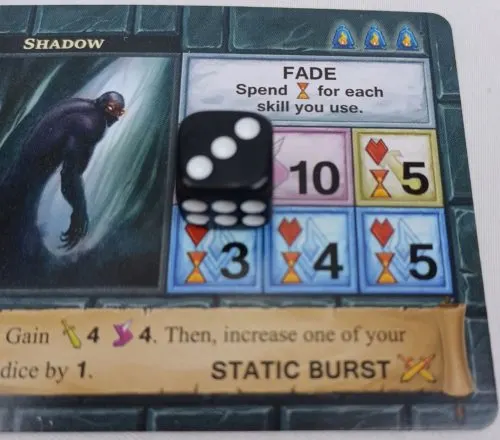
Playing One Deck Dungeon
One Deck Dungeon is played over a number of turns. Each turn consists of two steps.
- Time Passes
- Explore Or Enter A Room
After you have completed both steps, you will move onto the next turn.
Time Passes
To start each turn some time will pass to simulate the time spent moving through the dungeon.
To simulate the passage of time you will discard cards from the top of the encounter deck. Each turn begins with you discarding the top two cards.
Whenever an hourglass symbol is activated, it means that one card will be discarded from the top of the encounter deck.
Explore Or Enter A Room
The player(s) will then choose whether they want to explore or enter a room.
Explore
While exploring the dungeon there is always the ability to have four door cards placed on the table to choose from. Some of the dungeons may limit the number of doors you can have out at one time below four though.
To begin the game there will be no doors to explore so you must take the explore action. When you take the action you will take cards from the top of the encounter deck and place them door side up in the middle of the table. You will keep drawing and placing cards until there are four cards on the table.
After the first turn you can choose the explore option whenever there are less than four doors on the table. Face up encounter cards count towards the four door limit. If there are doors still on the table, you will only add cards until there are four on the table.
If the stairs card is visible (you have gone through the entire encounter deck), you can no longer take the explore option until you move onto the next floor of the dungeon.
Enter A Room
When you choose this action you will choose one of the encounter cards on the table. If the door is still showing you will turn the card over. The player(s) will then decide whether they want to face the encounter or if they want to flee. If you choose to flee the turn ends immediately and the card remains encounter side up on the table. If you chose a door that was already open, you cannot choose to flee.
When you choose to face the encounter you will first look to see if you will be facing combat or a peril. This is shown at the top of the card by the symbol next to the name of the card. The two types of encounters are mostly handled the same with a couple small differences. The ultimate goal is to try and fill in as many of the boxes on the card as possible in order to avoid consequences. Both types of encounters follow six steps.
Step One: Begin the Encounter
If you are facing combat you will first look at the foe’s special ability. This will be outlined in the top box on the card. This ability goes into effect immediately. If you flee the combat you will not have to deal with this ability.
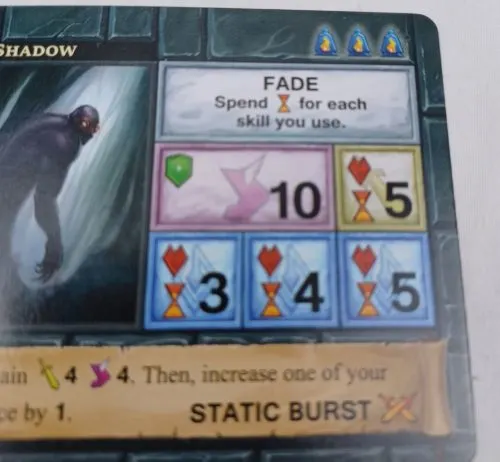
Each peril offers you two choices to try and overcome the obstacle. The player(s) must decide which of the two options that they will try to complete. Some options will cost time, so if you choose one you will discard the corresponding number of cards from the encounter deck. The choice not selected will be ignored completely.
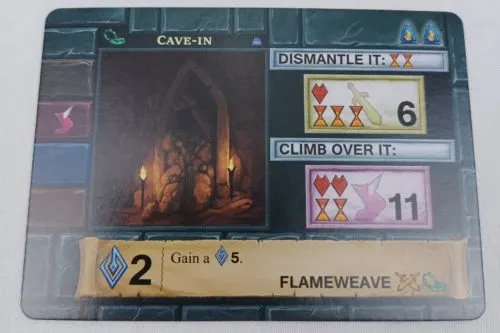
Step Two: Use Heroic Feat
Each hero has a heroic feat. These feats give you access to heroic dice but may require you to meet certain criteria to use them. You can choose whether you want to use your hero’s feat. If there are two players one player will decide whether they want to use their feat before the other player has to decide.
Most heroic feats cannot be used during the boss fight which is indicated by a skull symbol.
Some hero cards store dice on them when certain events happen. These dice are not used until the player decides to use the heroic feat.
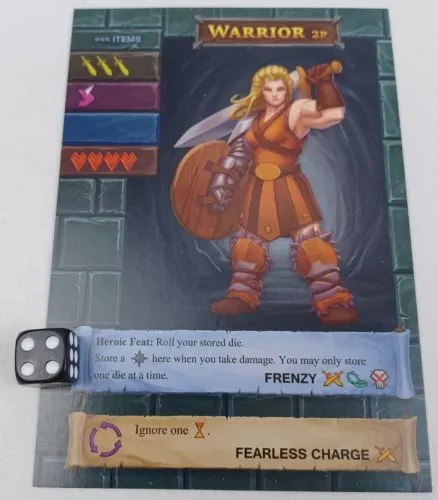
Step Three: Gather and Roll Dice
On each hero card there will be a number of symbols shown in the top left corner. You will take one dice of the corresponding color for each symbol. As you advance through the dungeon you will be placing cards underneath your hero card which will give you additional symbols/dice. If there are bonus dice, the players will determine which player will get to roll these bonus dice.
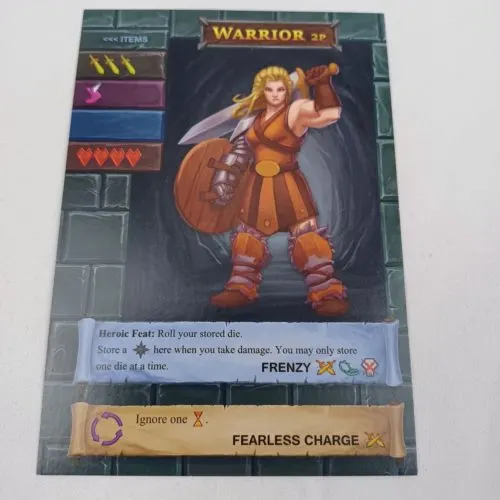
Once you have gathered all of your dice, you will roll all of them. In peril encounters you will only roll the dice that match the color of the option that you chose.
All of these rolled dice will constitute your dice pool which will be used to cover up challenge boxes on the encounter card. If the encounter card has a special ability that forces you to discard certain dice, these will apply before any hero skills can be used.
Step Four: Use Skills and Place Dice
At this time you can start to cover up the challenge boxes as indicated in the dice section above. The dungeon card will also feature a number of challenges that you must complete. The challenges you must complete depends on whether you are in combat or are facing a peril. The number of challenges you must complete depends on the current floor of the dungeon that you are on.
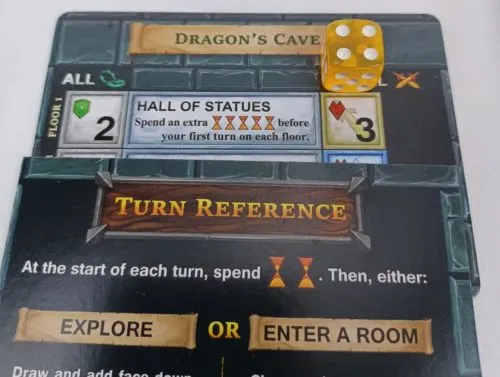
When placing dice you must first cover all of the challenge boxes that features armor (a shield icon).
To help with covering up the challenge boxes, the player(s) can use skills or potions. For more details check out the Skills and Potions section.
Finally you may discard any number of dice from your dice pool to the general supply. This may be helpful if you need these discarded dice for a skill that you want to use.
Step Five: Suffer Consequences
The objective of each encounter is to cover all of the challenge boxes. If you successfully cover all of the challenge boxes you will suffer no consequences for the encounter.
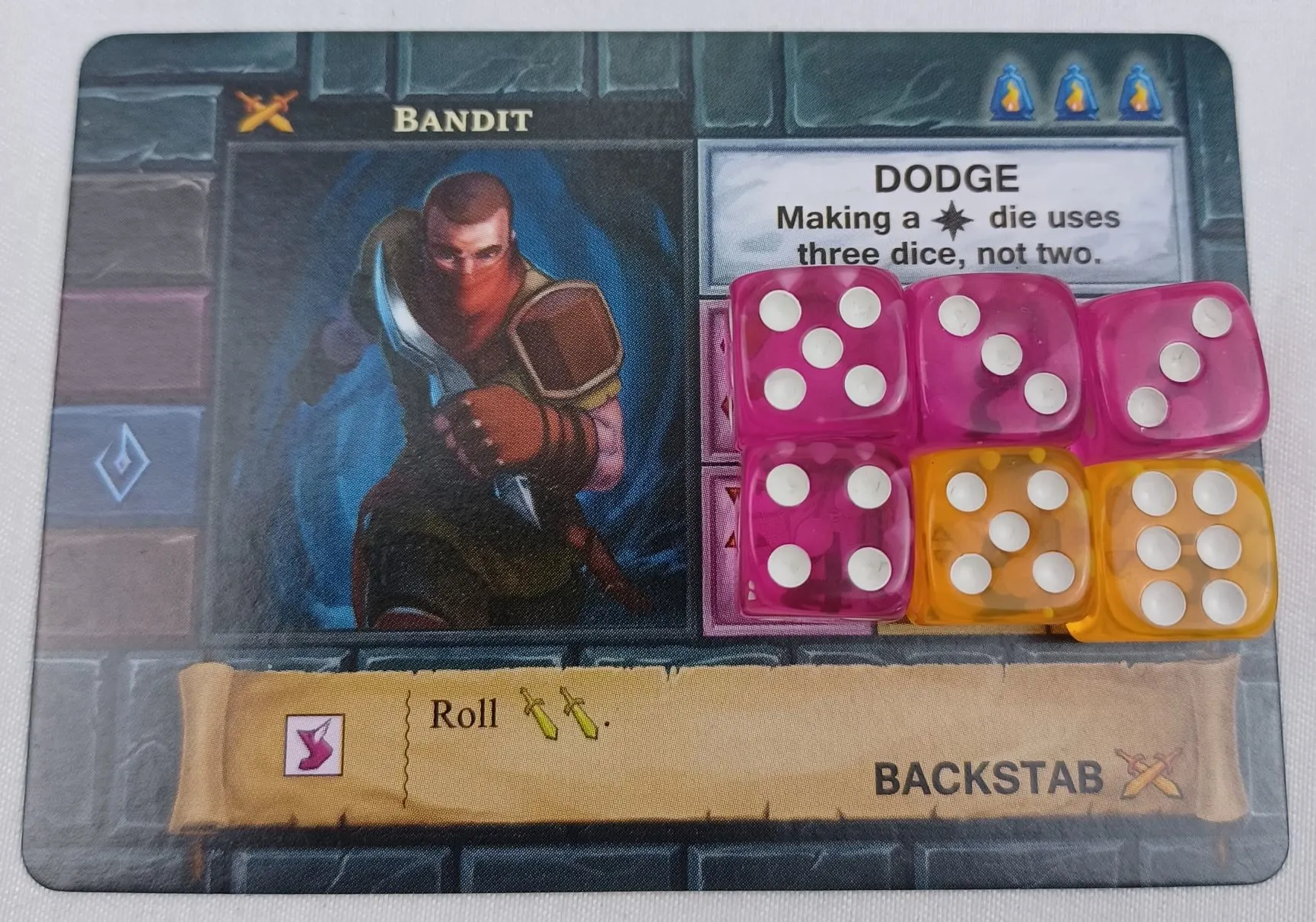
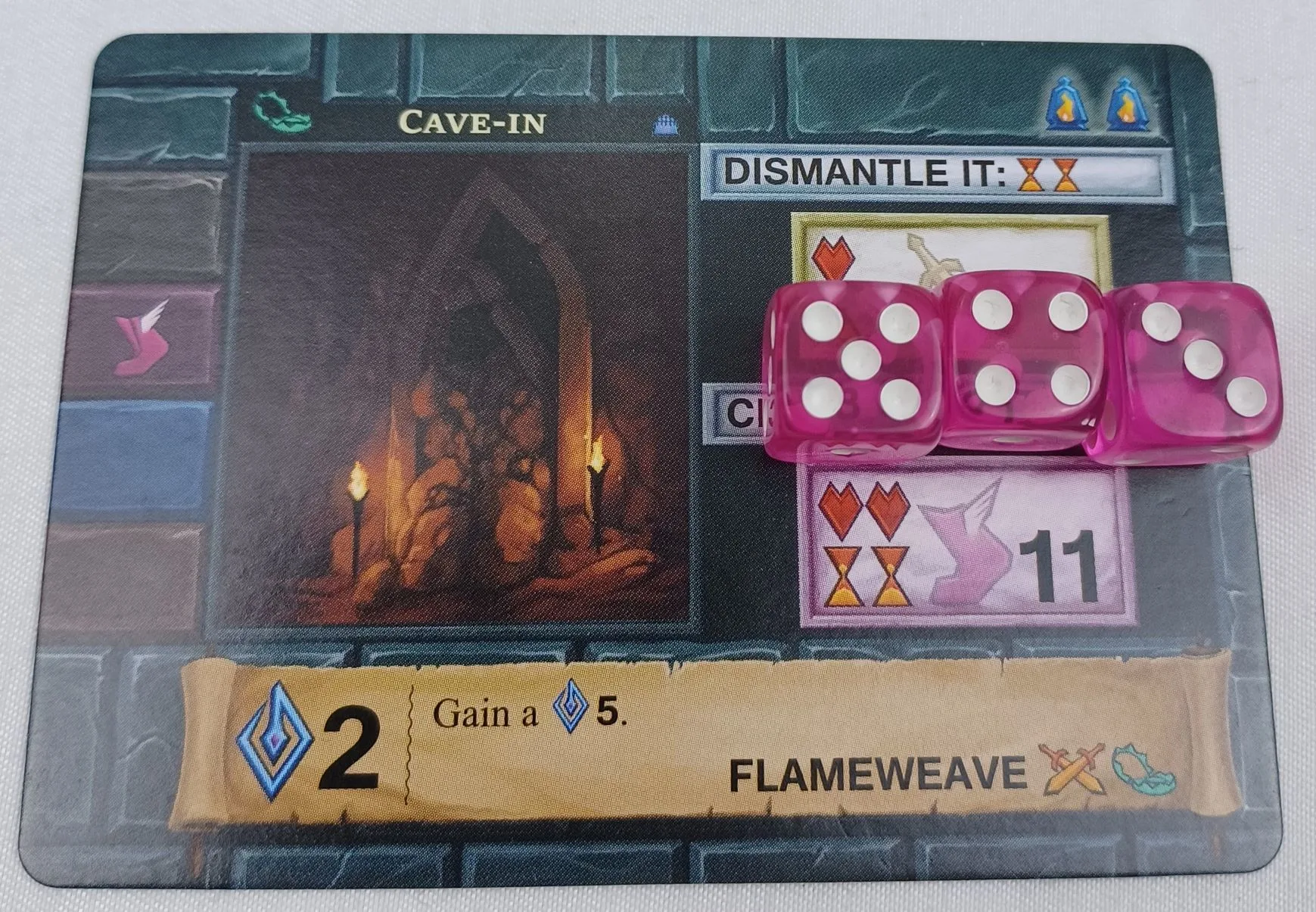
For each challenge box that is not successfully covered though you will suffer the consequences as shown on the box.
For each heart symbol you will receive one point of damage. In two player games the damage must be split as evenly as possible. You will take damage tokens from the supply and place them on the hero cards to indicate damage taken.
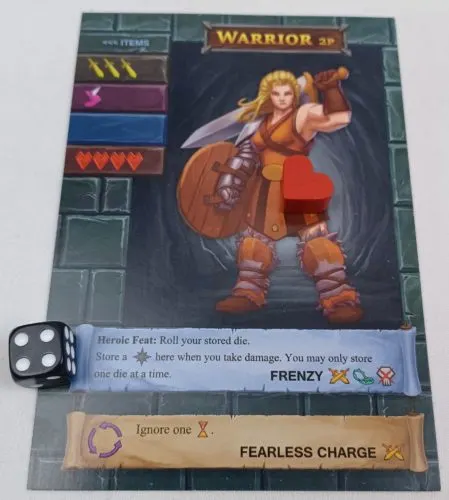
Each hour glass will require you to discard one card from the top of the encounter deck.
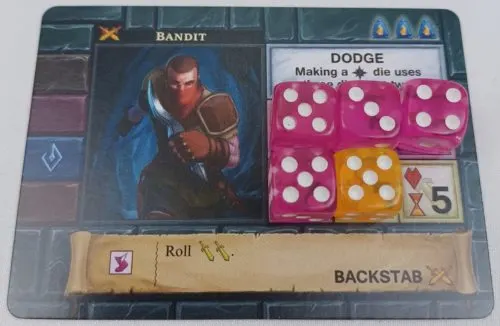
If any of the heroes have received more damage tokens than their current health, the game immediately ends with the player(s) losing One Deck Dungeon. You are given the option to try and heal before this happens though (see using potions below).
Step Six: Claim Loot
After you have completed an encounter and suffered any consequences it is time to receive your reward for completing the encounter. Each encounter card that you beat can be used in one of four ways.
You can choose to take the encounter card as an item. Along the left side of the encounter cards are a number of symbols that match those on the left side of your hero card. If you choose to take the card as an item, you will slide it underneath your hero card so these symbols will be added to the left of your hero card. These will give you additional dice to use for each encounter.
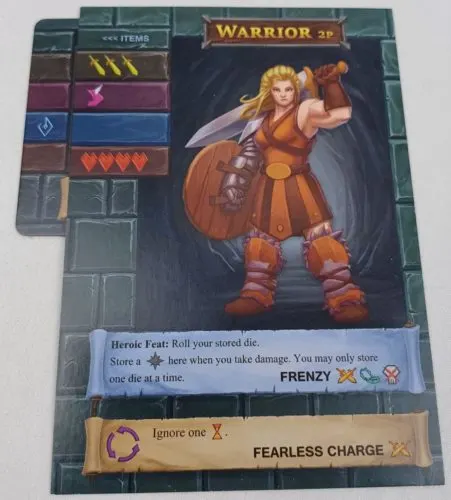
Each encounter card has a skill printed along the bottom. If you would like to use the encounter card for a skill you will slide it under the bottom of your hero card so the action is still visible. A hero may never have a duplicate skill.
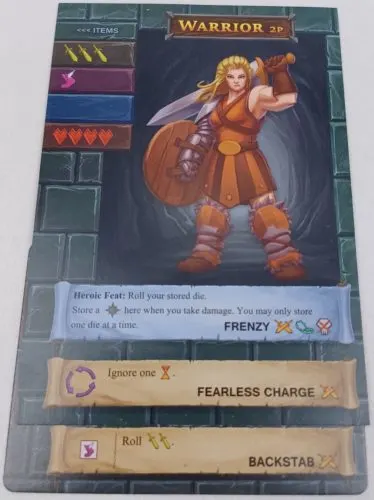
An encounter card can be used to identify a new type of potion. To use the card as a new type of potion you will slide it under the bottom of the turn reference card. When you identify a new potion type you will add another potion token to your turn reference card. These tokens can be used for any of the potions that you have unlocked so far. You can only identify each type of potion once in the game.
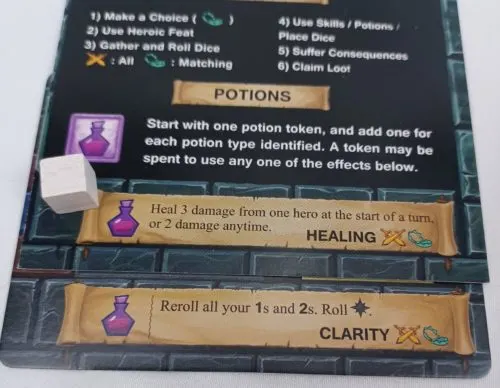
Finally you can use an encounter card for experience. Along the top of the car is a number of symbols which indicate how much experience the card will be worth. To take the card as experience you will slide it under the right side of the level card so the experience symbols are still visible.
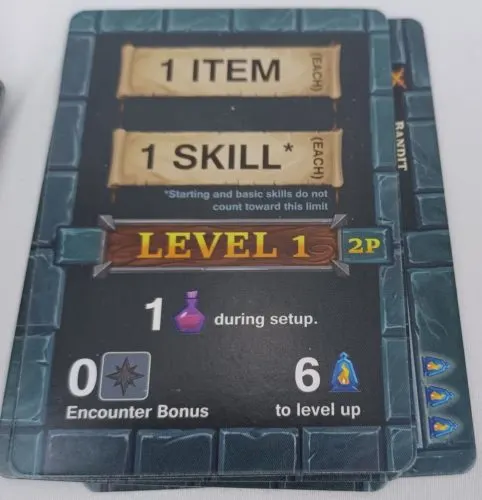
Your current level limits how many items and skills you can have equipped to a hero at any time. If you have hit your limit for item or skill cards, you can still use a new encounter card for that reward. You will have to discard one of the corresponding item/skill cards that you have already added to your hero though. The card you choose to discard will be turned into experience.
Skills and Potions
The skills that a hero can perform are found at the bottom of the hero card. Along the left side of the skill is the cost that must be paid to use the skill. The player who has the skill has to pay the entire cost. The right side details the skill’s effect. Each skill can only be used once per encounter. Some skills can only be used in certain types of encounters (combat or perils) as indicated by the symbol next to the skill’s title.
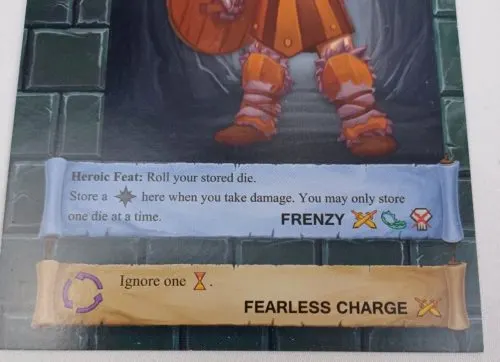
You also can use a potion token to take advantage of one of the types of potions that you have collected throughout your adventure.
The various costs to use skills and potions are as follows:
Strength/Agility Skills: You will discard a number of the corresponding type of dice from your dice pool.
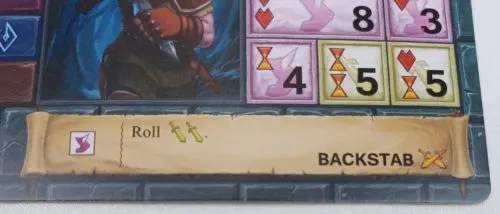
Magic Skills: You will discard blue dice from your dice pool which add up to at least the number shown.
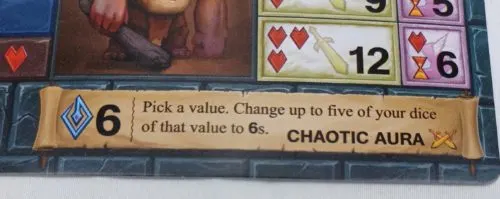
Free Skills: These skills have no cost to use them.
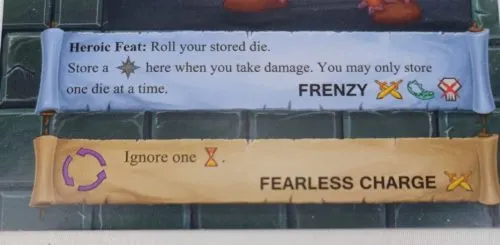
Potions: To use this you must discard one of the potion tokens from the turn reference card.
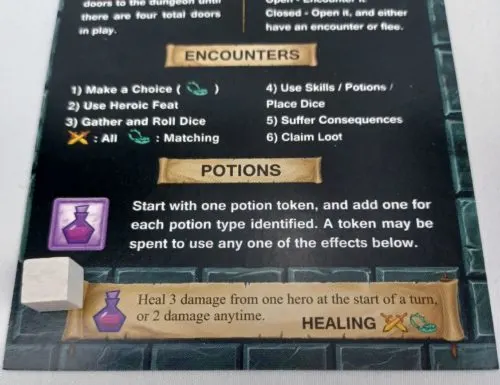
The effects of using a skill/potion are as follows:
- Gain: Take a corresponding die from the general supply and add it to your pool turned to the indicated side.
- Roll: Take a die of the specified color, roll it, and add it to your dice pool.
- Increase: Change the value of one of the dice from your pool by the indicated amount. A die may never go above six or below one.
- Reroll/Change: Gives you the ability to change dice already in your dice pool.
- Prevent: Allows you to ignore specific symbols during the suffer consequences step.
- Discard: Place the die in the general supply.
Healing and invisibility potions can be used at any time.
Leveling Up
Once you have acquired enough experience as indicated on the current level card, you will increase your level by one. All players will increase their level at the same time. You will remove enough encounter cards used for experience to reach the amount of experience required to level up. The discarded experience cards will be returned to the box.
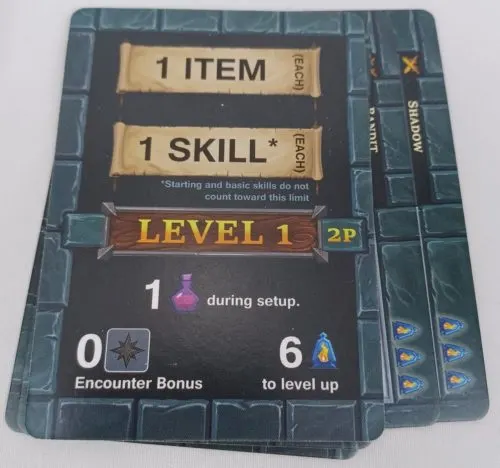
You will then remove the current level card to reveal your new level. By increasing your level you will gain one potion token. You will also be able to equip more items and skills. Each level will also give you access to a number of heroic dice that the players will get to use each encounter. The players will decide which player will get to use the dice each encounter.
Once you reach level four, you cannot gain any more levels. You may spend five experience to gain a potion token though.
Descending
Once the stair card is visible you must decide whether you want to descend to the next level of the dungeon or stay on your current level.
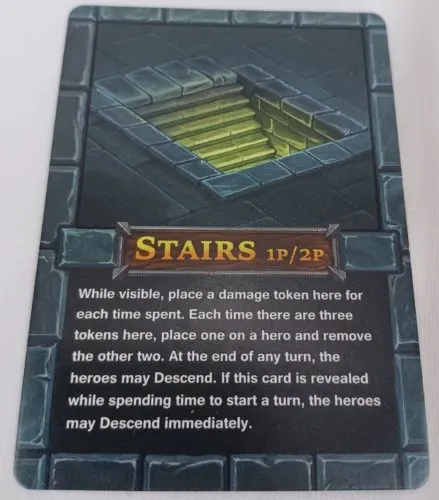
Instead of discarding cards for time spent, you will add a damage token to the stairs card. Once three damage tokens are added to the stairs card, one of the players will take one damage. The three damage tokens will then be removed from the stairs card.
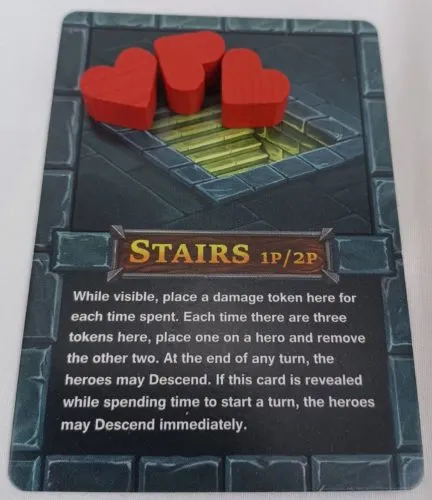
Players can choose to descend to the next level at any time. All encounter cards not placed behind cards or in the box will be shuffled to create the encounter deck for the next floor. The stairs card will be placed on the bottom of the new encounter deck. Slide the dungeon card up to reveal the effects of the new floor. All of the visible dungeon effects are now in play.
Boss Fight
Once you descend from the third floor you will enter the boss fight. You will flip over the dungeon card to reveal the boss. The boss fight consists of multiple rounds until either you or the boss is defeated. Along the bottom of the boss card is the bosses health which you have to deal in order to win the fight.
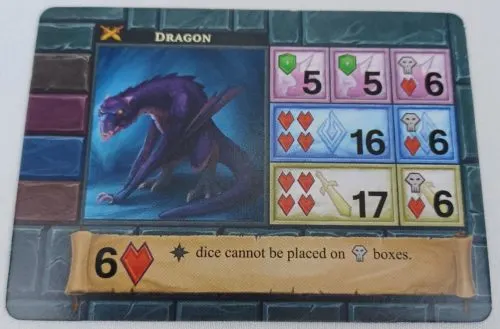
Boss fights are treated similar to normal combat. You cannot use heroic feats if they feature the skull symbol. You are trying to cover up the boxes on the card like in a normal fight. Any spots that are not covered up will force the players to suffer consequences.
If one of the players run out of health and can’t heal, the boss fight is over and the players lose.
For each skull symbol that is covered up, the players will deal one point of damage to the boss.
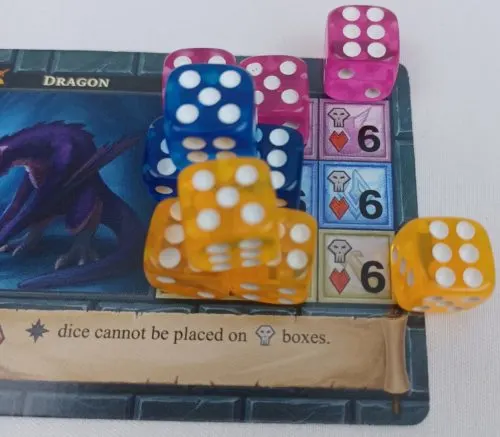
If the boss still has health remaining another round is played.
If the players deal damage to the boss equal to or more than its health (over several rounds), the players have defeated the boss and have won One Deck Dungeon.
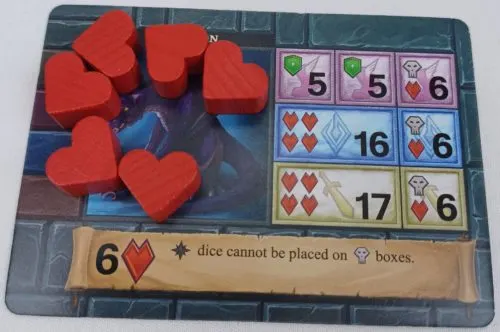

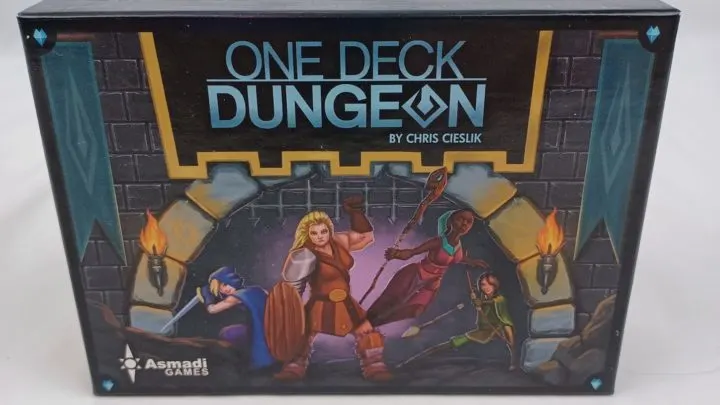
One Deck Dungeon Board Game Review - Geeky Hobbies
Friday 15th of April 2022
[…] would like to see the complete rules/instructions for how to play One Deck Dungeon, check out our how to play […]